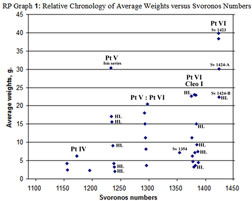The Chronology of Second Century Ptolemaic Bronze Coins:
Two Different Methods to Graphically Interpret Weight/Size Data
Graphing of weight data versus Svoronos numbers gives an illustration of the chronology of 2nd century bronze coinage
This page, and the parts that follow, show that F&L's weight and size data can be used with Svoronos' numbers not only to give an illustration of the relative chronology of second century bronze coinage but also to give corrections to F&L's reattributions of several types of coins. |
|
As shown below, the chronological aspect of the types can be made numeric by the use of Svoronos numbers and the result is a graphic illustration (see RP-Graph-1, left) of the weight versus chronology of second century Ptolemaic bronze coinage. |
Svoronos’ catalogue numbers are widely used to indicate a specific type of coin listed in his monumental compilation of Ptolemaic coins. His cataloguing placed related coins into series with later series having greater Svoronos numbers. Therefore, a Svoronos number not only indicates a specific coin type but may also give a distinct numeric indication of relative chronology that can be used in scatter graphing. However, adjustments must first be made to those few Svoronos numbers where attributions have been changed (mainly because of new hoard data) since production of his catalogue in 1904. Then, for each type of coin in the data tables, Svoronos numbers are used with scatter graphing to give a meaningful presentation of average weights (g) versus chronology (Sv numbers); the results are shown in RP Graph 1 above.
|
|||||||
